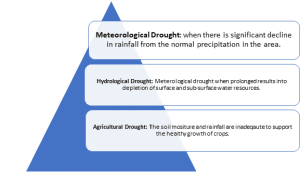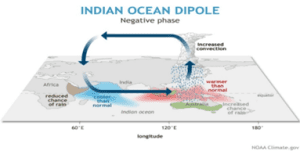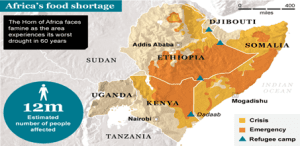Answer.
APPROACH
Introduction- Define drought and mention its types briefly. State the fact about drought-prone areas in India.
Use the pictographic presentation to mention types of droughts as given by National Commission on Agriculture.
The Body
-
- Briefly cover causes of droughts-begin with scarcity of rainfall, then focus on other factors concerning water resource mismanagement.
- May draw one associated diagram depicting El Nino or Indian Ocean dipole.
- Address the impacts of drought on society, economy and environment, along with significant examples where necessary.
- Finally, give mitigation measures for drought, as suggested by NDMA in its guidelines.
Conclusion- Mention a few government initiatives aimed at addressing this concern.
Introduction:
Drought can be generally understood as an extended period of unusually dry weather in the absence of enough rainfall. According to Drought Early Warning System, about 42% of India’s land area is susceptible to droughts, and around 6% area experiences extremely dry conditions. Drought is a slow onset of hazard, unlike sudden extreme weather events like floods, earthquakes, volcanoes etc.
Drought has been classified into three types by the National Commission on Agriculture in India: meteorological, agricultural and hydrological.

The Body:
Causes of drought tied to rainfall:
Rainfall deficiency over a long period of time is usually the major factor initiating natural calamities such as drought. The reasons behind the scarcity or absence of precipitation are as follows:
- Delays in monsoon: The hydrological and agricultural droughts are connected with the meteorological droughts, which are influenced by the intensity and variability of precipitation and wind patterns such as monsoon. The delays in the onset of monsoon or prolonged breaks in monsoon are causative factors in droughts in the Indian Subcontinent. The impacts of El Nino and Negative Indian Ocean Dipole (IOD) are noteworthy in causing droughts.
El Nino weakens the trade winds and onset of South-West Monsoon in India.
In the event of negative IOD, warmer waters gather around the Australian coast in such a way that above-than-average waters are observed in the East Indian Ocean while below-than-average cooler waters are present in the Western margin of the Indian Ocean. Consequently, there occurs a delay in the onset of monsoon, which causes droughts in India.

The reduction in the speed of rain-laden monsoon winds or change in their route results in long dry spells during the monsoon season, which aggravates conditions of drought in areas such as Marathwada.
- Climate Change-induced droughts: The IPCC Assessment Reports 5 and 6 clearly demonstrate the rise in frequency and intensity of droughts as extreme weather events due to Climate Change since the rising temperatures and increased variability of rainfall contribute to dry spells, heatwaves, forest fires and droughts as a consequence.
The wetter regions are expected to become wetter, and the drier regions are even drier in the wake of climate change.
Examples of such droughts include the Horn of Africa, Nagaland droughts etc.

Flash droughts known to occur within weeks and intensifying within months have been attributed to global warming and climate change. Such sudden and intense droughts double the abnormally dry conditions to over 60% in affected regions. An example includes droughts in the MidWest Region of the USA (2012).
- Effect of Ice Ages: The transition from the Medieval Warm Period to the Little Ice Age was marked by severe droughts between 1302 and 1307 in Europe.
inefficient water resource management as cause of droughts:
There is growing evidence that suggests how the droughts are not merely rainfall-deficiency events but are influenced to a large extent by inefficient water resource management, which is both a quantitative and qualitative issue.
- Overexploitation of Groundwater: The population explosion in developing countries like India and the increase in the demand for water result in the over-exploitation of aquifers, which exacerbates the problem of water scarcity in regions where rainfall is deficient.
Furthermore, the overexploitation of groundwater also results in the contamination of groundwater with uranium, arsenic, lead etc., as is the case in the North-Gangetic Plains of India.
- Water-Guzzling Crops: The agriculture sector draws about 70% of the groundwater. The cultivation of water-hungry crops (paddy, sugarcane) in non-traditional areas, which was given thrust by the Green Revolution in Punjab, Western Uttar Pradesh, and Haryana, has caused depletion of the groundwater table in the region and increased the vulnerability of drought in such regions.
Recent studies indicated the impending droughts and famines in the state of Assam due to over-utilisation of groundwater because of the cultivation of three to four crops a year instead of the normal two cropping seasons.
- Diminishing Wetlands: The rising pace of industrialisation and urbanisation, other than the growing demands of land for settlements and agriculture, have led to encroachments over wetlands. Wetlands act as natural sponges and filters for water. So, the vanishing wetlands have a direct bearing on water availability in the affected region and drought as an aftermath.
- Inefficient Rainwater Harvesting: Without effective and large-scale rainwater harvesting, only limited recharge is taking place. There is little progress in the renovation of traditional rainwater harvesting structures despite various government initiatives focusing on watershed management like HARIYALI guidelines, Jal Shakti Abhiyaan etc. Coupled with deficient rainfall, this creates a situation of drought in the regions.
- Unsustainable Urbanisation: The rapidly increasing urbanisation at the cost of forests and wetlands has increased concretisation and exacerbated the phenomenon of droughts. Massive deforestation disturbs the hydrological cycle and regularity of the rainfall as such.
- Water Pollution- The discharge of untreated industrial and agricultural waste into water bodies deteriorates the quality of water, which adds to apprehensions of drought in vulnerable regions.
Also, the intrusion of saline water into freshwater in the coastal regions on account of sea level rise tends to worsen the problem of water scarcity in the coastal regions.
- Dam mismanagement: The damming of rivers in the upper reaches of the river often contributes to droughts in lower riparian states since they depend on upper riparian states for water for irrigation, drinking water and hydroelectricity. Also, dams tend to change the natural flow and chemistry of rivers, causing episodes of droughts and floods.
Socio-economic impacts of droughts:
- Agricultural Productivity: The loss of soil moisture and prolonged dry conditions during drought trigger the loss of soil biodiversity, accelerate soil erosion and cause a drastic fall in agricultural productivity. As a result, farmers face losses, fall in income and increase in debts and suicides.
- Famines and Hunger: The dips in crop yields influence the nutritional security as well as food security of the country/region. The instances and intensity of malnutrition and hidden hunger surge in areas under the spell of droughts, such as Nigeria, Somalia, Kenya, South Sudan etc.
- Water Stress and Migration: Drought-prone areas are marked by high levels of water stress and forced migration. As per UNCCD estimates, about 700 million people would be displaced by droughts by 2030, and about one in every four children would be deeply affected by extreme water shortages.
- Diseases: The unavailability of water because of drought forces people to depend on the deplorable quality of water, which puts the health of humans, particularly the most vulnerable sections (children, elderly, women), at risk of water-borne diseases. This, in turn, raises the mortality rates, healthcare demands and fiscal burden on the State.
The lack of access to water deteriorates the sanitation and hygiene conditions which lead to compromised health conditions and deaths from starvation.
- Social Tensions: Under conditions of unemployment, loss of livelihood and mental distress, communities often engage in conflicts and crimes. Further, women in rural areas are compelled to fetch water from far-away places, which affects their survival and health directly.
- Water Conflicts: The drying up of rivers and attempts to secure drinking water, water for irrigation etc., is likely to increase tensions among the states and countries. The case study of the Helmand River (dispute between Iran and Afghanistan) the Nile River serve as classic examples of water disputes.
In India, several inter-state river water disputes linger around the same concerns. e.g., Cauvery water dispute between Karnataka and Tamil Nadu
- Industrial slowdown: Water serves various purposes in different industries such as mining, iron and steel, paper and pulp industry etc. The scarcity of water in the wake of drought for industrial processes halts the economic wheels and impinges on the growth of the nation.
The agro–based industries are severely affected. The hydropower plants serving electricity to industrial agglomerations also get depressed with the drying of water reservoirs.
- Regional Imbalance: The inequalities between various regions/countries becomes sharp and widened due to droughts in some pockets and normal weather conditions in its counterparts.
ENVIRONMENTAL IMPACTS OF DROUGHTS:
The hydrological cycle is disturbed when the conditions of drought prevail. This impacts the environment in the following ways:
- Wildfires: The dry, warm conditions during drought accelerate heatwaves and incidences of forest fires. Examples include the Amazon, Siberia, the Congo basin, and Central parts of India, where forest fires have been raging in the past few years.
- Loss of biodiversity: The terrestrial life and insects pollinators have recorded drastic falls in their population with the rising temperatures and droughts. The lack of water within forests induces wild animals to move to peripheral villages and causes human-animal conflict.
The food chains get disrupted, and ecological imbalances set in with severe drought conditions.
- Land degradation: Soil erosion occurs at a fast pace when the vegetation is meagre, and drought conditions persist, for instance, the regions in Sub-Saharan Africa, the Amazon basin, the Malwa plateau (India) etc. The area under Badland topography and parched lands increases because of acute droughts and soil erosion.
- Loss of aquifers: Droughts result in the disappearance of rivers, ponds, lakes etc. and the depletion of the water table. This further impacts the micro-climate of the regions. For instance- the urban heat island effect becomes more pronounced.
Measures for drought mitigation:
Drought mitigation programmes are not stand-alone interventions to be taken in the wake of a drought. Rather, they should be integrated with the government’s development planning:
- Decentralised approach: Instead of a national drought mitigation plan, State governments must plan and implement a localised, decentralised State Drought Mitigation Strategy with the help of local urban and rural governance bodies.
- Drought Vulnerability Assessment: A scientific approach with inputs from remote sensing and information technology, drone mapping etc., should be utilised by authorities for scientific planning and proper assessment of drought-prone micro and macro-regions. Risk assessment should include the identification of drought-prone areas of the State, the nature and severity of drought, vulnerable economic sectors, communities and individuals.
- Afforestation: Vegetation and wetlands play a crucial role in the hydrological cycle. Emphasis should be given to the creation of green belts, green walls, reforestation, compensatory afforestation, restoration of wetlands and mangroves etc., through a community-based approach.
- Watershed management: A cluster approach must guide the implementation of micro-watersheds throughout the country. The existing schemes, such as Pradhan Mantri Krishi Sinchayi Yojana, Integrated Watershed Management Programme etc., should be strictly implemented and, monitored, reoriented as and when needed.
- Rainwater Harvesting: States with higher vulnerability to droughts must imitate the example of Tamil Nadu to enforce mandatory rainwater harvesting by every household. The funds from MGNREGA must be wisely utilised by local bodies for the creation and renovation of rainwater harvesting structures.
- Capacity-building: Capacity building and training of all functionaries and stakeholders involved in watershed programme implementation should be carried out aggressively with a definite action plan, requisite professionalism and competence.
- Sustainable Agricultural Practices: Those agricultural practices which promote groundwater recharge, prevent soil erosion and preserve soil moisture, such as contour bunding, mulching, gully plugging, micro-irrigation, need to be promoted among farmers with the help of civil society organizations and efficient agricultural extension services.
- Drought-resistant crops: Farmers must be incentivised through the MSP regime and awareness drives to cultivate drought-resistant, climate-friendly crops such as millet and feasible GM crops. Institutional research for development of such varieties of crops must be allocated adequate budgetary support by the state and central governments.
- Integrated Basin Planning: Taking inspiration from the Tennessee Valley Authority (USA), the concept of integrated basin planning aimed at coordinating water resources plans throughout a river basin must guide the institutional framework for drought mitigation in India.
In India, the Damodar Valley Corporation covering the river Damodar and its tributaries in Bihar and West Bengal was modelled on the lines of the Tennessee Valley Authority.
- Inter-River linking: Inter-basin water transfer from surplus to deficit waters could serve as a long-term solution for the droughts and floods simultaneously. An example includes the Ken-Betwa River linkage project.
- Innovative community-based solutions: State governments must build on existing community-based innovations such as Pani Panchayats of Odisha and inspire more such efforts towards drought mitigation. In Rajasthan, communities are participating in checks on rainwater loss and thus ensuring the enhancement of groundwater.
Conclusion:
Around 33% of the cropped area in the country receives less than 750 mm of rain annually, making such areas hotspots of drought. Keeping in view the rising threat of droughts due to anthropogenic activities, further aggravated by Climate Change, the Government of India, in line with the UNCCD guidelines, has been proactively engaged in addressing the concern of droughts through the implementation of initiatives such as PMKSY-Accelerated Irrigation Benefit Programme, Atal Bhujal Yojana, Jal Jeevan Mission etc.
Spread the Word
